Introduction
In this article, I discuss some time-saving tips for people who maintain Drupal websites. By installing a few modules you can do certain actions much faster.
What is Drupal?
Drupal is a content management system that allows you to build websites. A content management system ensures that you can place, modify and delete texts via an interface that is user-friendly.
The texts are stored in a database so that you can display them in several places on your website. This saves you a lot of time compared to other methods for building websites. Until recently, in order to build and edit websites, one had to know HTML" because though Drupal sites are all built using a WYSIWYG editor, they are still HTML.
Everyone can now quickly and easily create content on a website by using a CMS. But with Drupal, you can save even more time. Below I discuss a number of those time-saving functions.
Automatically generate search engine friendly URLs
When you create new content in Drupal (in Drupal this is called a 'node'), the system itself creates a URL where this content can be found. In principle, there is nothing wrong with this, because Drupal knows how these URLs work. When you create a menu item to this node, Drupal knows that this URL should be used.
Drupal Uniqueness
Search engines like Google, however, are not happy with this URL. It does not give any information about what can be found on the page. Ideally, the URL contains the title of the page and the category to which the content belongs. Imagine: you write news about animals and you have your own category for each animal species. You have created a node with the title 'How can you clean up the best dog hair?'.
Generating such a URL is not possible with Drupal by default, but fortunately, there are free extensions (modules) available. These modules give your Drupal website extra functionality. The module that can create these URLs is called Pathauto.
Make links to pages within your own Drupal website
When you create a new page, it is possible that you want to create a link in this text to another page on your website. By using the link option you can link to the other page. You must manually enter the URL of the page you want to link to.
If you use the Pathauto module, however, this can cause problems. For example, you want to go to the "How can you clean up the best dog hair?" - link news. You then enter the URL generated by Pathauto. Nothing wrong. But what happens when you change the title of the dog hair news? For example, you have expanded the news so that it is about the hair of all kinds of animals. Pathauto will automatically generate a new URL. Now you have a problem because the link you just created no longer refers to the correct page and is, therefore, a 'dead' link.
Linkit module
With the Linkit module, you can prevent this. Install the link module and the pathologic module and switch on both. Go to the management section of Drupal to 'Settings' and then to 'WYSIWYG profiles'. If all goes well, you have the CKEditor WYSIWYG editor on 'Full HTML'. Click edit for this profile.
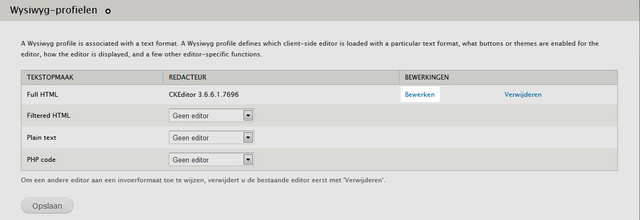
Now open the 'Buttons and Plugins' tab. You will now see an overview with all buttons that are enabled in your WYSIWYG editor. Find the 'Linkit' button, activate it and save the profile.
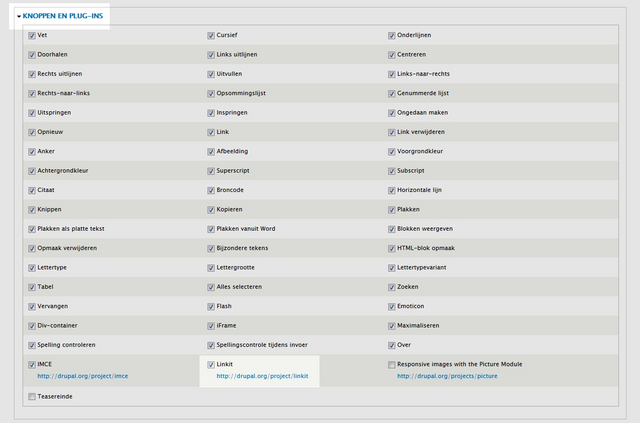
Go back to settings and click on 'Linkit profiles'. Click on 'Add new profile'. Enter a management title and a name, for example: 'general'. In 'Profile type' you choose 'Editors' and at the tab 'Search plugin' you choose the parts you want to link to link it. In most cases, you only have to tick 'content'. If you also want to link to other parts such as comments or users, you can also tick this. Save the profile.
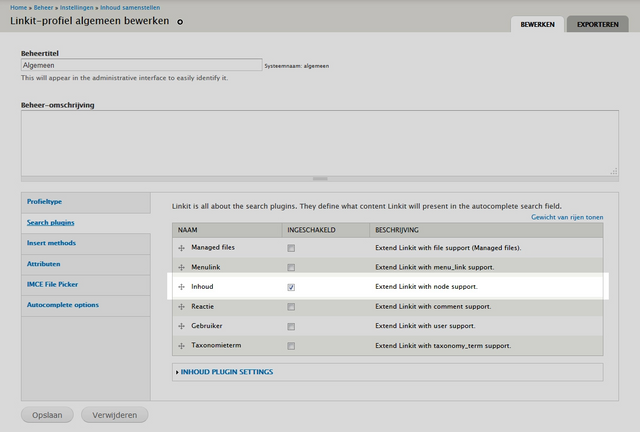
For the last step, you go to 'Settings' and then to 'Text format'. In 'Full HTML' (or the text formatting format you have set up the WYSIWYG editor for) click on 'Set'. Check the 'Correct URLs with Pathologic' checkbox and save the settings.
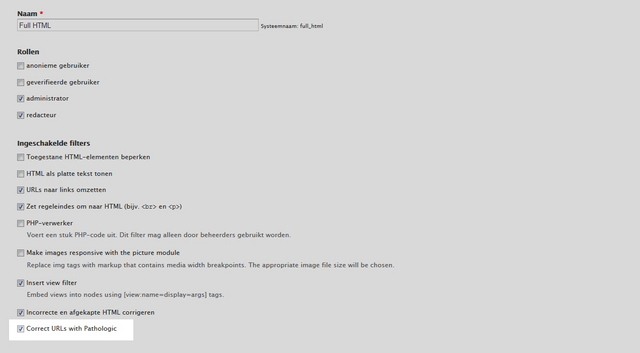
When you create a new node now, you will see an extra button appearing in the editor of the fields where the WYSIWYG editor is on (for example the 'body' field). This is the link button (the chain with the plus sign).

Type the text you want to link to another page on your website and select it. When you click on the link button a pop-up will appear. The 'search for content' field works through a system that automatically complements your text. Enter the first three letters of the page you want to link and link it automatically gives suggestions of pages that contain these characters.
Select a page from this list. You now see that at 'Link URL' the default Drupal URL is entered and not the search engine friendly URL generated by Pathauto. This does not matter at this time. So you can safely click on 'Insert link'.

Once you save the article, this Drupal URL is automatically converted to the URL created by Pathauto. This is the work of the Pathologic module. When saving a node, Pathologic checks all links and replaces standard Drupal URLs for URLs created by Pathatuo.
A clearer way to manage your content with Drupal
If you have a lot of content, managing this content can become unclear. The standard page that gives an overview of all your content within a Drupal website is somewhat limited. For example, you can only filter items by status (published or not), type (a type of content) and language (when the website is multilingual).

Installing and activating the Administration Views module
By installing and activating the Administration Views module, this overview page is immediately expanded. You can now filter by title, type, author, status and glossary (taxonomy terms).

It is even possible to manually extend this overview page with fields that are important to you. However, this requires some knowledge of the 'Views' module. If you want to walk this path, I advise you to follow the Views tutorial of Drupal in 24 days.
You can adjust the overview by going to 'Structure> overviews' and clicking on Edit at the 'Administration: nodes' overview. All buttons and options may be overwhelming at first, but once you've got it, setting up your own overview page can save you a lot of time.
A better menu in the management section
If you manage a Drupal website, you are constantly navigating between the different pages in the management section of Drupal. This navigation can sometimes be a bit difficult because the menu in the management section is very simple.

Administration Menu module
With the Administration Menu module, you can make this menu very user-friendly. Install and activate the menu. Please note that when activating the Administration Menu module you also switch off the standard 'Toolbar' module.
Otherwise, you get a double menu bar in the management section of your Drupal website. You immediately see a difference between the Administration Menu and the menu that is installed by default. By hovering with your mouse over menu items you can navigate to the underlying pages more quickly.

Hopefully, the above tips will save you a lot of time. The time that you now hold for important things. Do you have any tips for Drupal yourself that save time or do you have questions about the tips above? Leave a comment and I will respond as soon as possible.
Thank you for the contribution. It has been approved.
You can contact us on Discord.
[utopian-moderator]
Downvoting a post can decrease pending rewards and make it less visible. Common reasons:
Submit
Hey @debraycodes, I just gave you a tip for your hard work on moderation. Upvote this comment to support the utopian moderators and increase your future rewards!
Downvoting a post can decrease pending rewards and make it less visible. Common reasons:
Submit
Thank you for your contribution.
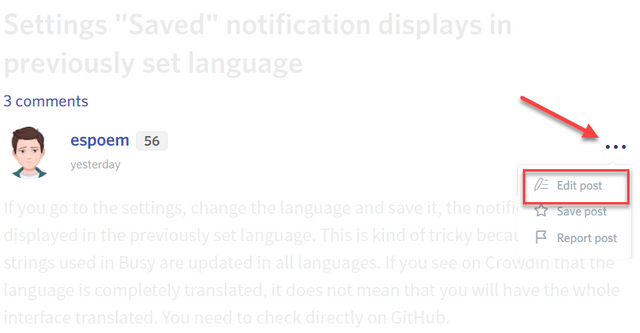
It cannot be approved yet because you have some typos and grammatical errors. This post is very informative and with a little proofreading and restructuring would be a great example of the content that we seek for the platform. Please reply to this comment when you have updated the post in order for it to, at that time, be approved.
See the Utopian Rules. Please edit your post at this link, as shown below:
You can contact us on Discord.
[utopian-moderator]
Downvoting a post can decrease pending rewards and make it less visible. Common reasons:
Submit
i have edited it
Downvoting a post can decrease pending rewards and make it less visible. Common reasons:
Submit
Can you edit this sentence "Previously, websites only consisted of HTML pages " to read something more along the lines of "Until recently, in order to build and edit websites, one had to know HTML" because though Drupal sites all built using a WYSIWYG editor, they are still HTML... Edit that and I'll approve you right away.
Downvoting a post can decrease pending rewards and make it less visible. Common reasons:
Submit
Thank you for your response. That was really kind of you. I have done just as you instructed.
Downvoting a post can decrease pending rewards and make it less visible. Common reasons:
Submit
i have edited the post by checking all typos and grammatical errors .for approval
Downvoting a post can decrease pending rewards and make it less visible. Common reasons:
Submit
This is the link of the fresh posting of the edited one https://utopian.io/utopian-io/@beulahlandeu/5dfcux-save-time-with-your-drupal-website
Downvoting a post can decrease pending rewards and make it less visible. Common reasons:
Submit
Hey @beulahlandeu I am @utopian-io. I have just upvoted you!
Achievements
Suggestions
Get Noticed!
Community-Driven Witness!
I am the first and only Steem Community-Driven Witness. Participate on Discord. Lets GROW TOGETHER!
Up-vote this comment to grow my power and help Open Source contributions like this one. Want to chat? Join me on Discord https://discord.gg/Pc8HG9x
Downvoting a post can decrease pending rewards and make it less visible. Common reasons:
Submit
Hey, I just want to thanks you! I've build my website with Drupal and I am always happy to learn something new.
Downvoting a post can decrease pending rewards and make it less visible. Common reasons:
Submit
good job
Downvoting a post can decrease pending rewards and make it less visible. Common reasons:
Submit